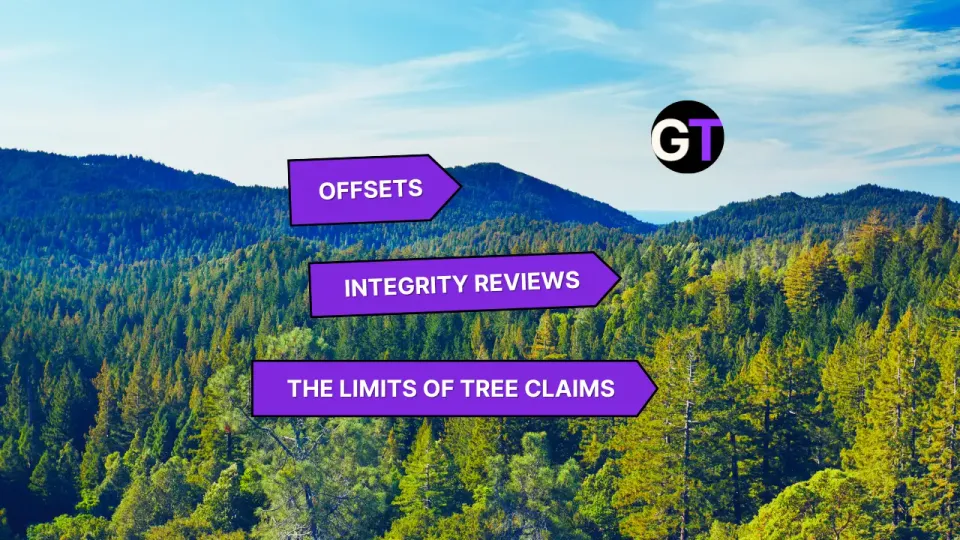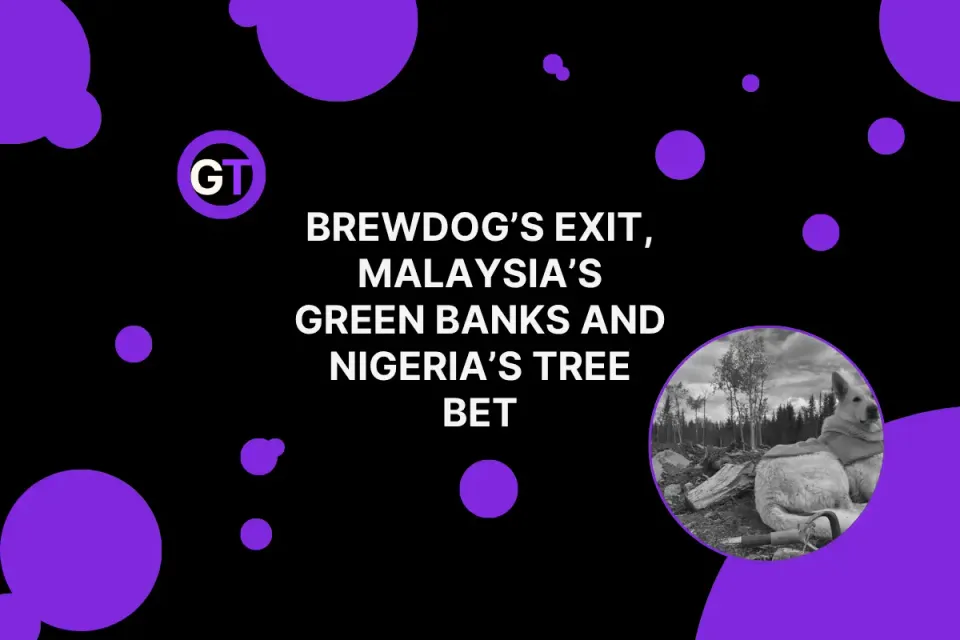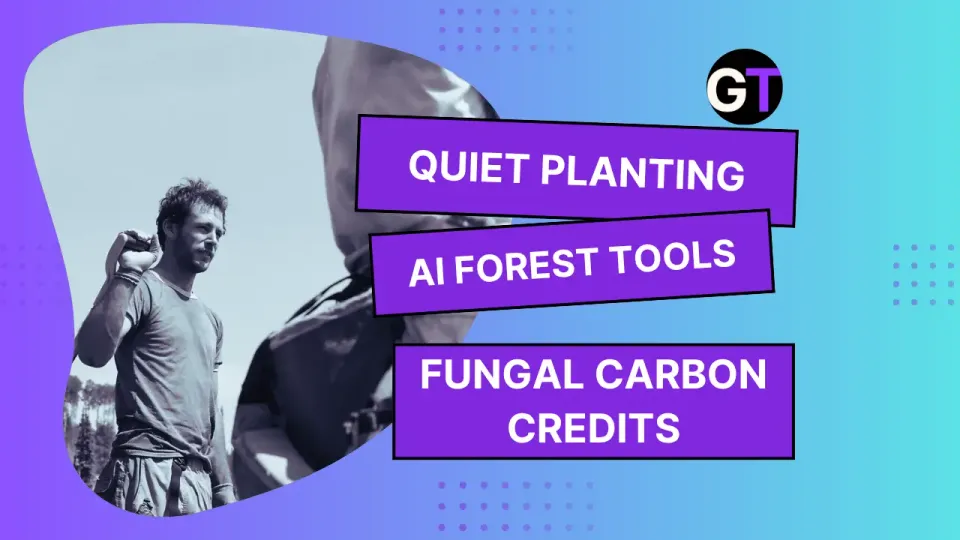Weekly Forest News, May 23
From shaky corporate climate claims to record forest fires, this week’s forest news asks: who's really walking the green talk?

Corporate Climate Action: Still Standing—But Was It Ever That Bold?
Despite political rollbacks and ESG backlash, a new PwC report finds over 80% of companies are sticking with or ramping up climate goals. But let’s not pop the champagne just yet—only 16% of top firms are actually on track, and most are still ghosting Scope 3 emissions and broader influence. Underfunded teams, corporate greenhushing, and low ambition from key sectors mean the bar for “bold” might need serious raising.
💬 Can companies ditch the PR gloss and deliver the full-spectrum climate action we actually need—for example, planting one trillion trees?
👉👉 Read more at Project Drawdown
UN Approves Key Rules for Paris Agreement Carbon Credit System
The UN’s Supervisory Body has adopted crucial new standards under the Paris Agreement Crediting Mechanism (PACM), setting a global benchmark for how climate projects estimate emissions reductions and address leakage. With a minimum 1% baseline reduction over time and tighter REDD+ integration, the move aims to ensure credits are truly “real, additional, and verifiable.” The rules will help guide developers and nations in building high-integrity carbon credit projects aligned with national climate goals—though initial funding gaps may slow rollout until new projects scale in 2026.
💬 Will these new baseline and leakage rules set the bar high enough for trust in international carbon markets?
👉👉 Read more from UN Climate Change
EU’s Anti-Deforestation Law Targets “The Real Baddies” – and It’s a Short List
Brace for barked diplomacy: the EU is reportedly blacklisting just four countries under its Deforestation Regulation—Belarus, North Korea, Myanmar, and Russia—while giving heavy-hitter exporters like Brazil and Indonesia a pass (for now). This hush-hush list, greenlit by member states, reflects a cautious move by Brussels to only penalize nations already under EU or UN sanctions, despite pressure from NGOs who argue for a reality check based on actual environmental risk. The list determines how rigorously companies must vet imports like palm oil, soy, and beef—a big deal for global trade, though critics fear it's more geopolitics than green policy.
💬 Is this blacklist just political pruning, or a strategic sapling in a bigger forest of reform?
👉👉 Read more at Euractiv
Tracking Nature’s Pulse: A Smarter Way to Monitor Nature-Based Solutions
In a world scrambling to make nature-based solutions (NbS) live up to their hype, a new framework out of the UK says, “Let’s stop winging it.” Warner et al. (2025) have delivered a metric-driven master plan for monitoring ecological outcomes, both above and below the ground. The team ranked biodiversity and soil health indicators into tiers—from Tier 1 MVPs like earthworm abundance and species diversity to future-forward metrics that still need tech to catch up. The goal? High-integrity, high-impact restoration. Armed with a searchable online tool and a practical case study, the framework is designed for real-world use—even on shoestring budgets. With remote sensing, eDNA, and acoustic monitoring in the mix, it’s not just science—it’s ecological CSI. Bottom line: This isn't just about trees or microbes—it's about making sure NbS actually work, not just look good on paper.
💬 Are we finally ready to monitor ecosystems like we mean it?
👉👉 Read more at One Earth
Soil Meets Sky: A Monitoring Makeover for Nature-Based Solutions
In a bid to supercharge the credibility of nature-based solutions (NbS), researchers from Oxford and Aberdeen universities have laid down a nerdy-yet-vital blueprint for tracking both above-ground biodiversity and below-ground soil health—because trees and microbes deserve equal billing. Their proposed metric framework sorts indicators by informativeness and feasibility into three tiers (think Hogwarts house sorting, but for data), ensuring that restoration projects don’t just say they’re eco-friendly, they can prove it. From earthworm counts and fungal diversity to vegetation structure and landscape diversity, the system offers a buffet of measurable metrics supported by standardized methods—many drawn from UK protocols but with global potential. With added tech flair (hello, drones and eDNA), the approach embraces the modern monitoring multiverse while keeping one foot grounded in practical realities.
💬 Can a smarter checklist help NbS live up to their Earth-saving hype?
👉👉 Read more in Wiley Online Library
National Greening Program in the Philippines: A Billion-Dollar Mirage?
Launched in 2011 with dreams of reforesting two million hectares and planting 1.8 billion trees, the Philippines’ National Greening Program (NGP) has turned out to be less of a green revolution and more of a grand illusion. An investigation using satellite imagery and government data revealed widespread deforestation in NGP sites — with one in every 25 hectares experiencing forest loss instead of gain. Many “reforested” areas were already forested before being cleared and replanted with monoculture crops. Communities were given short-term land access, little support, and complex bureaucratic hurdles, pushing some into illegal logging and greenwashing. Billions were spent, yet the promised forests remain largely imaginary, and environmental goals unfulfilled. Even program architect Marlo Mendoza admits: “We planted trees. But where are they?”
💬 Can planting reports without trees still count as climate action?
👉👉 Read more on PCIJ
Carbon Markets Evolve: High-Quality Over Hype in Patch's 2025 VCM Report
In a world where climate policy whiplash is the norm (yes, the U.S. ditched the Paris Agreement—again), companies aren't bailing on carbon markets. Patch’s new report unveils a subtle upheaval in the voluntary carbon market: fewer carbon credits retired overall, but a 6% bump in the number of companies stepping up—opting for quality over quantity. The market is splitting in two: engineered and hybrid carbon removal projects (think biochar and direct air capture) are the new VIPs, while nature-based projects are squeezed by supply limits. Meanwhile, “greenhushing” is on the rise—25% of companies are going climate-silent to dodge accusations of greenwashing. Long-term offtake agreements, à la Microsoft and Meta, are becoming essential as demand outpaces supply and credit prices climb. TL;DR: the carbon game is getting smarter, stealthier, and a lot more selective.
💬 Is your carbon strategy still stuck in 2020?
👉👉 Dive into the full report from Patch
From Gravel Pit to Green Haven: Reforesting Erie County's Past
Once a gravel mine, now a hopeful forest-to-be—100 acres near Lake Pleasant in Erie County are getting a dramatic eco-makeover. Nonprofit Bosland Growth is planting 70,000 trees in the scarred soil, teaming up with Western Pennsylvania Conservancy to turn compacted ground into thriving wildlife habitat and a future carbon sink. The effort, powered by carbon credit revenue, includes experimental plots with biotech firm Funga adding fungi-rich soil and biochar to supercharge growth. The stakes are high: water quality, rare species, and climate resilience all hang in the balance. This is no ordinary tree-planting—it's a science-fueled resurrection of a glacial gem's ecosystem, one sapling at a time.
💬Can a fungus-laced bucket of dirt reboot Pennsylvania’s post-industrial landscapes?
👉👉 Read more at The Allegheny Front
Tanzania’s Tobacco Forest Fix Falls Flat
In Tanzania’s tobacco heartland, a 70-year saga of “plant a tree, save the forest” is showing more smoke than fire. A new study tracking land use from 1956 to 2020 across the Urambo, Uyui, and Kaliua districts reveals a 62% decline in forest cover—despite decades of afforestation campaigns tied to the country’s booming tobacco trade. Blame population growth, land-hungry farming, and a misguided tree strategy: eucalyptus woodlots. These fast-growing imports don’t meet the needs of farmers or ecosystems, and only cover 4% of the region. Worse still, the annual rate of forest loss (315 sq km) stomps the area reforested (455 sq km total). Researchers suggest switching to native species like Gmelina arborea and incorporating longer fallow periods and smarter harvest cycles to truly restore the land. Because right now? Tanzania’s forest recovery efforts are barely treading water in a sea of smoke and stumps.
💬 Can a nation’s green dreams grow in tobacco soil?
👉👉 Read more in Springer
Forest Fraud Probe Exposes Reforestation Greenwashing in Southeast Asia
A new cross-border investigation reveals how protected forests in the Philippines and Indonesia are being sacrificed under the guise of "re-greening" for monoculture plantations and commodity exports. In the Philippines, one in every 25 hectares of National Greening Program land has experienced deforestation—often cleared to grow cash crops with little benefit to local communities. Many sites remain barren, short-term land access incentivizes logging, and monoculture licenses leave farmers vulnerable to global price swings. With the EU’s Deforestation Regulation looming, the report urges a rethink on what real forest restoration should look like.
💬 Can we redesign reforestation to serve both ecosystems and economies?
👉👉 Read more at Journalismfund Europe
Global Forest Loss Hits Record High as Fires Outpace Agriculture
The world lost 6.7 million hectares of tropical primary forest in 2024—an area nearly the size of Panama—with fires overtaking agriculture as the leading cause of destruction for the first time on record. Brazil alone accounted for 42% of this loss, fueled by the Amazon's worst drought in decades. Bolivia followed with a 200% spike, and even the Congo Basin saw unprecedented declines. But not all is lost—Indonesia and Malaysia showed notable drops in deforestation, offering a flicker of hope.
💬 Can global cooperation and innovation turn the tide on forest loss?
👉👉 Read more in The Guardian
Symbiosis Coalition's First RFP Targets Scalable Carbon Removal
The Symbiosis Coalition, backed by tech titans like Microsoft and Google, is pushing for high-integrity carbon removal at scale with its first Request for Proposals (RFP). Aimed at reforestation and agroforestry projects worldwide, the RFP drew 185 submissions spanning 49 countries, collectively proposing over 6.6 million hectares of restoration and more than 180 million tonnes of CO₂ removal over 10 years. While many projects showed strong ecological and community benefits, common hurdles included weak carbon accounting and unclear long-term sustainability plans. Symbiosis is now vetting top contenders and offering technical support to help more projects meet its ambitious quality bar.
💬 Can corporate-backed coalitions like Symbiosis shift the market toward quality-first carbon removal—or are we still rooting for unicorns?
👉👉 Read more here
IKEA Dedicates 16,000 Hectares to Climate-Smart Forest Research
IKEA is teaming up with the European Forest Institute and Preferred by Nature to test new forestry methods across 16,000 hectares in Latvia. The initiative will explore closer-to-nature forestry, continuous cover models, and biodiversity-focused management, aiming to scale successful strategies across IKEA’s global forest holdings and beyond. With climate change rewriting the rules of sustainable land use, this partnership fuses science and practical know-how to future-proof forest landscapes.
💬 Can corporate-led conservation projects like this genuinely drive positive change—or just polish reputations?
👉👉 Read more at IKEA.com
Regenerating Forests Age Poorly Without Policy Support, New Global Map Shows
A new study in Nature Ecology and Evolution reveals that more than half of the world’s regenerating tropical forests are under five years old and highly vulnerable to being cleared again. Only 6% are over 20 years old—mostly in the Americas—highlighting the fragility of global natural regeneration. While natural regrowth is fast and efficient for carbon capture and biodiversity, its long-term survival depends on landscape integrity and supportive policies. The study calls for urgent financial, legal, and societal action to protect these young forests from the chopping block.
💬 Can regeneration scale up without rethinking how we value young, vulnerable forests?
👉👉 Read more in Nature Ecology and Evolution
Ontario’s Biodiversity Scorecard: Mixed Progress, Mounting Pressure
The latest State of Ontario’s Biodiversity 2025 report is out, and the results are, well, a mixed bag of climate reality and cautious optimism. Despite increased awareness (a whopping 88% of Ontarians back biodiversity investment), more than half of Ontario’s 2025 targets show “little progress,” especially on habitat loss, climate resilience, and species protection. Wetlands are vanishing, rare species are floundering, and volunteer numbers haven’t bounced back post-pandemic. Still, new data tools, updated policies, and a revamped 2023–2030 strategy point to a province trying to turn the tide.
💬 Can better data and broader coalitions finally put Ontario’s biodiversity on a recovery path?
👉👉 View the full report here

Edited by Chris Harris

This work is licensed under a
Creative Commons Attribution 4.0 International License.





